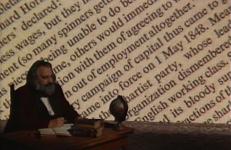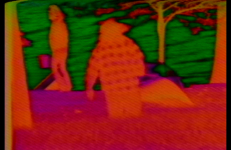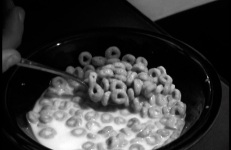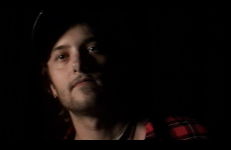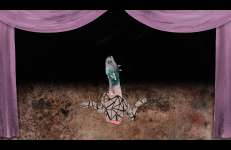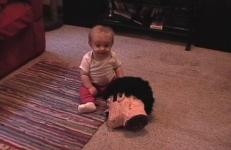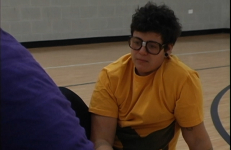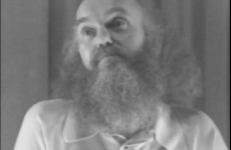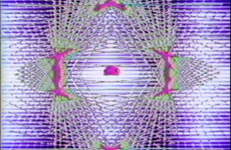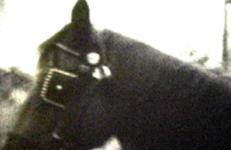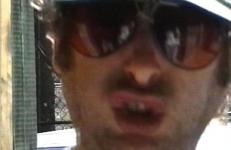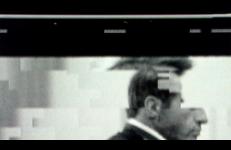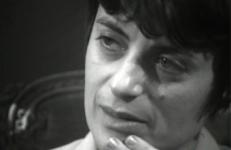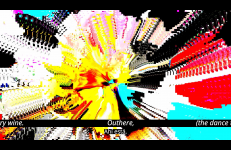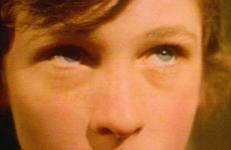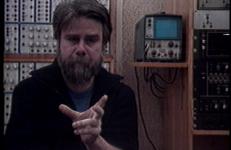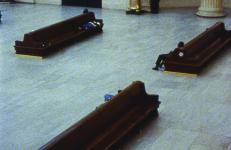Kipnis describes this tape as "an appropriation of the aesthetics of both late capitalism and early Soviet cinema—MTV meets Eisenstein—reconstructing Karl Marx for the video age.” She presents a postmodern lecture delivered by a chorus of drag queens on the unexpected corelations between Marx’s theories and the carbuncles that plagued the body of the rotund thinker for over thirty years. Marx’s erupting, diseased body is juxtaposed with the “body politic", and posited as a symbol of contemporary society proceeding the failed revolutions of the late 1960s.
Chicago Art
An over thirty-minute static long take of a grass lawn in front of a lake. A camera is set still to capture a day trip of a group of people around the lake. The causal conservation suggests they are having a picnic on a breezy day, where a wind chime occasionally rings, alongside the random blowing of a horn. The video processing focuses on the keying of two distinct areas: the lake and the surrounding grass lawn and trees.
In this 2004 interview, Kori Newkirk (b.1970) describes his lifelong apprehension of being rooted in any one place for too long. Asserting that the School of the Art Institute of Chicago was the fifth school he attended in four years, Newkirk begins by describing the fortuitousness of his relocation to Chicago following his expulsion from Cooper Union. Recounting how he fled from the fiber department in favor of painting, Newkirk details how it was a studio visit from Deborah Kass and an exchange program to England that crystallized his burgeoning ideas about “painting without making paintings.”
A two part treatise on needs, met and unmet. A painter putters around his apartment. Spoils his cereal with rotten milk, gets a do-over with a fresh gallon. Over the course of the filming the relationship between the performer and the filmmaker unravels into disclosures of childhood sexual abuse. Rotten milk is the metaphor for all human suffering.
A trans performers enacts an improvised strip-tease in silence, adhering to directions of positioning and movement. The performance fails to reveal genitals. Perspective oscillates between three stages of distance from the subject; re-focusing and reframing the (lack of) genital revelation.
Now That I've Lost My Buffalo, I Don't Know Who to Grind is a short animation conceived through the collaboration of three visual artists — Diane Christiansen, Jessie Mott, and Alejandra Trigoso — that stages a volatile theater of bodies in flux. Within a shifting frame, cut-out fragments of animals and humans slip in and out of view, forming and unforming as creatures that vomit, expel, and rearrange their own parts. The work resists stable form, instead embracing mutation, rupture, and play as its guiding principles.
Now That I've Lost My Buffalo, I Don't Know Who to Grind is a short animation conceived through the collaboration of three visual artists — Diane Christiansen, Jessie Mott, and Alejandra Trigoso — that stages a volatile theater of bodies in flux. Within a shifting frame, cut-out fragments of animals and humans slip in and out of view, forming and unforming as creatures that vomit, expel, and rearrange their own parts. The work resists stable form, instead embracing mutation, rupture, and play as its guiding principles.
Now That I've Lost My Buffalo, I Don't Know Who to Grind is a short animation conceived through the collaboration of three visual artists — Diane Christiansen, Jessie Mott, and Alejandra Trigoso — that stages a volatile theater of bodies in flux. Within a shifting frame, cut-out fragments of animals and humans slip in and out of view, forming and unforming as creatures that vomit, expel, and rearrange their own parts. The work resists stable form, instead embracing mutation, rupture, and play as its guiding principles.
In 1998 I made a sculpture of a decapitated head. I featured it in a photo and video. I thought of the head as a character whose adventures would be documented. The name O’Malley was inspired by Chicago’s Irish heritage (I was living in Chicago then). O’Malley’s Head Part 1 was a photo of the head placed on top of the garbage cans in the alley behind my apartment building. I lived right by an exit ramp from the Kennedy Expressway, one of the last before you reached downtown from O’Hare Airport. Sometimes people would exit there and dump things.
Polish-American arist Ed Paschke (1939-2004) received his BFA from the School of the Art Institute of Chicago in 1961 and his MFA in 1970. Paschke was known as a member of the late-1960s Chicago Imagist movement, a group of artists who called themselves The Hairy Who, whose expressive style of figurative painting was rooted in outsider art, popular culture, and Surrealism. Paschke's fascination with the print media of popular culture led to a portrait-based art of cultural icons. Paschke used the celebrity figure, real or imagined, as a vehicle for explorations of personal and public identity with social and political implications.
Path combines striking imagery of the earth’s topography from the air, the ground, and beneath the sea. With calming shots of living ocean coral and acrobatic aerial footage of the Illinois prairie, Path investigates the physical sensations of the body as it moves through time and space, closely observing the natural world.
Spanish artist Jaume Plensa (b. 1955) creates sculptures and installations that intend to unify individuals through their relationship to memory, the body, and spirituality. Often referencing literature, psychology, biology, and history, his practice speaks of a shared humanity despite the world’s complexity. In this way, language acts as a metaphor, and the human figure a universal symbol. Plensa is perhaps best known for works that engage groups of people in public spaces.
This single channel tape was created from a 4-channel live mix of 4 VCRs, an A/V mixer, and a sampler. Hypnotic music, idiosyncratic singing, and soft, yet insistent voiceovers accompany television images portraying notions of happiness, the work ethic, and social success in a subtly alienating video collage. "Repeat with me: I now feel confident about opening to others and projecting charisma."
Budlong Memorial Middle School is heating up. Queer Teen Romance is a charmingly perverse homage to the after-school special that tackles bullying in a hormone-fueled flurry of forbidden sexual fantasy. When Bryce, the school bully, picks on outcast Kevin, a group of tough (and brightly accessorized) girls decide to teach Bryce a lesson. But maybe Kevin doesn’t want the pain to stop?
Ram Dass, born Richard Alpert, was a spiritual guru and crucial figure in the early research of psychedelics alongside Timothy Leary in the 1960s–70s. In the early 70s, he gave a lecture at the Art Institute of Chicago. He began by mentioning a recent interaction with Sidney Cohen with whom he had co-authored the book LSD (1966). Ram Dass discussed being on a panel with Cohen about substance use in Washington D.C.
Video from the 2nd Interactive Electronic Visualization Event (IEVE), a collaboration event with SAIC's Video Department and the University of Illinois Circle Campus. Rescanning of IEVE, edited by Phil Morton, includes documentation of the event, video of the artists using the Sandin Image Processor and other synthesizing equipment, and the video and sound created by the artists.
Image Processing by Phil Morton, Audio Synthesis by Bob Synder, Image Generation by Gunter Tetz.
A young communist girl named Sharambaba resists her suitor in a carriage. She speaks of what he calls her "fantasy world". All of the dialogue is played backwards with accommodating subtitles.
This title is also available on Jim Finn Videoworks: Volume 1.
Shooter explores the idea of overt manliness, exposing it to be a flaccid gesture and an exercise in posturing. In the video, I assume the persona of a metal head wandering an urban landscape, making threatening yet empty gestures to passersby to create an exaggerated sense of power and machismo. I use three different songs by Motorhead, that are never allowed to get past the opening guitar riffs, to further construct a sense of masculinity that falls back onto itself. I also utilize humor to facilitate exposing the paradoxes contained within my actions.
An homage to Chicago's East 95th Street Bridge, Calumet Fisheries and to a couple of the city's infamous brothers. The take-out shack, originally glimpsed in the background of a scene from The Blues Brothers, still operates. It has become a real-world portal to a cinematic past. Propped along the edge of the 95th street drawbridge, the building is framed by the towering infrastructures of the Chicago Skyway and Calumet Harbor.
Hollis Sigler (1948–2001) was a Chicago-based artist. She received degrees from both Moore College of Art and the School of the Art Institute of Chicago. Her mature artistic style was faux-naïve, featuring paintings whose subjects, furniture and clothing set in doll-house type interiors and suburban landscapes, were stand-ins for the implicitly female figure. She was an openly lesbian artist and a prominent member of the faculty of Columbia College in Chicago.
"Love at first sight, one night, down at Silverror’s Saloon!" Mickey R Mahoney and jonCates direct Silverror’s Saloon, the next film in the 鬼鎮 (Ghosttown) Glitch Western series of films and games. Written by Emily Mercedes Rich and jonCates, this experimental film queers, glitches, and questions the Western film genre. We encounter characters caught in a glitched cinematic magic moment: a love scene. First dance with a stranger. Home and far from home.
"Love at first sight, one night, down at Silverror’s Saloon!" Mickey R Mahoney and jonCates direct Silverror’s Saloon, the next film in the 鬼鎮 (Ghosttown) Glitch Western series of films and games. Written by Emily Mercedes Rich and jonCates, this experimental film queers, glitches, and questions the Western film genre. We encounter characters caught in a glitched cinematic magic moment: a love scene. First dance with a stranger. Home and far from home.
The unusual combination of a sound like a singing saw accompanies sweet images of frolicking lambs in the meadow, galloping horses, and a strange boy, is eerily beautiful and pure.
This title is also available on Animal Charm Videoworks: Volume 1.
Bob Snyder is a Chicago-based composer, video artist, and author who has been experimenting with sound and video synthesis since the 1960s. As a musician, his interest has always been in the relationship between music and visual imagery. In Snyder’s work, music is the central generative source of meaning, although he also creates a dialogue between the sound and images of nature and architecture.
Interview by Rafael Franca.
1. The idea that a film about a city, a quiet, architectural film no less, can tell us anything that we don’t already know about urban life at this point in our new century is perhaps a bit arrogant. But the city is an organism that changes constantly; our knowledge of it is provisional at best. So a film that examines the urban environment under the cloak of darkness must presume to reveal a reality that we don’t know, and tries to dispel projections and fears that are for the most part located in the imagination... in a memory of film, television, or the novel.




